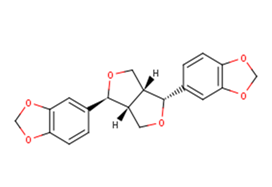
L-asarinin
CAS No. 133-05-1
L-asarinin( (-)-Episesamin )
Catalog No. M19423 CAS No. 133-05-1
Asarinin reduces peripheral blood concentration of IL-12 and inhibits the expression of CXCR3 and TLR4.
Purity : >98% (HPLC)
 COA
COA
 Datasheet
Datasheet
 HNMR
HNMR
 HPLC
HPLC
 MSDS
MSDS
 Handing Instructions
Handing Instructions
| Size | Price / USD | Stock | Quantity |
| 100MG | Get Quote | Get Quote |


|
| 200MG | Get Quote | Get Quote |


|
| 500MG | Get Quote | Get Quote |


|
| 1G | Get Quote | Get Quote |


|
Biological Information
-
Product NameL-asarinin
-
NoteResearch use only, not for human use.
-
Brief DescriptionAsarinin reduces peripheral blood concentration of IL-12 and inhibits the expression of CXCR3 and TLR4.
-
DescriptionAsarinin reduces peripheral blood concentration of IL-12 and inhibits the expression of CXCR3 and TLR4 which means Asarinin may have a role on the TLR4 pathway and produce prolongation of allograft heart survival.
-
In Vitro——
-
In Vivo——
-
Synonyms(-)-Episesamin
-
PathwayOthers
-
TargetOther Targets
-
RecptorOthers
-
Research Area——
-
Indication——
Chemical Information
-
CAS Number133-05-1
-
Formula Weight354.36
-
Molecular FormulaC20H18O6
-
Purity>98% (HPLC)
-
SolubilityChloroform Dichloromethane Ethyl Acetate Acetone etc.:Soluble;DMSO:Soluble
-
SMILESC5O[C@@H](c1ccc2OCOc2c1)[C@H]6CO[C@H](c3ccc4OCOc4c3)[C@@H]56
-
Chemical Name——
Shipping & Storage Information
-
Storage(-20℃)
-
ShippingWith Ice Pack
-
Stability≥ 2 years
Reference
1.Gu J. et al. The effect of Asarinin on Toll-like pathway in rats after cardiac allograft implantation. Transplant Proc. 2015 Mar;47(2):545-8.
molnova catalog



related products
-
Abscisic acid
Abscisic acid is a compound isolated from fruits and plants.
-
ACETOXYVALERENIC ACI...
Acetoxyvalerenic acid is a natural compound that could be found in valerian.
-
Emodin-1-O-β-D-gluco...
Emodin 1-O-beta-D-glucoside has neuroprotective and uncoupling activities, and that it may be the a new uncoupler of nNOS-PSD-95.



 Cart
Cart
 sales@molnova.com
sales@molnova.com


